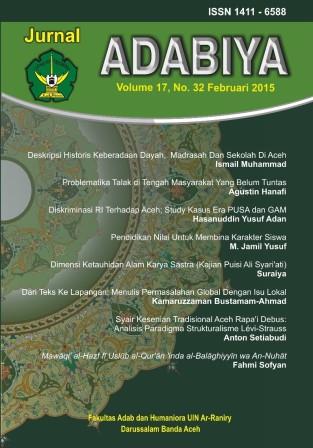Korban Penghilangan Paksa pada Konflik Aceh; Upaya Pemulihan dan Pemenuhan Hak Korban Melalui Mekanisme KKR Aceh
DOI:
https://doi.org/10.22373/adabiya.v24i1.12637Keywords:
Aceh, human rights, truth and reconciliation commissionsAbstract
Conflict victims are important entities in maintaining peace. However, after 16 years of peace in Aceh, there are still many victims and families of conflict victims who have not fully received attention, especially the families of victims of enforced disappearances during the Aceh conflict. Indeed, they need certainty about the whereabouts or status of their missing family members. This study examines the status of victims of enforced disappearances during the Aceh conflict and what rights of victims or victims' heirs can be resolved through the mechanism of the Truth and Reconciliation Commission. This research uses the perspective of history, law and human rights. The data used come from various sources. The data are then analysed, narrated and described qualitatively. The results of the study indicate that there are several steps that can be taken to carry out the rights of victims and families of victims of enforced disappearances, namely through a court decision process, in the context of Aceh carried out by the Mahkamah Syar'iyah. Courts need to establish legal status for victims as a form of recognition that enforced disappearances occurred during the conflict. After obtaining legal certainty, the next step is to accomplish the right of reparation through the Commission of Truth and Reconciliation. Then, followed by granting residence status; provision of missing person certificate; compensation for deceased victims; memorialization of victims; and excavation of mass graves.References
Al Chaidar, dkk. (1999). Aceh Bersimbah Darah. Jakarta: Pustaka Al Kausar
Conny R. Semiawan, Metode Penelitian Kualitatif, Jakarta: Grasindo.
Imam Ar-Rafi’i, (2005). Al-Muharrar fi Fiqhul Imam Asy-Syafi’i, Bairut: Darul Kutub Al-’Ilmiah
Komisi Nasional Hak Asasi Manusia, Lembar Fakta HAM, Edisi III
Kontras. (2006). Aceh; Damai Dalam Keadilan? Mengungkap Kekerasan Masa Lalu. Jakarta: Kontras
Mely G. Tan. (1991) Masalah Perencanaan Penelitian, dalam Koentjaraningrat, Metode-Metode Penelitian Masyarakat. Jakarta: Gramedia Pustaka Utama
Mukhtar Yahya dan Fatchur Rahman, (1986). Dasar-Dasar Pembinaan Fiqh Islami, Bandung: PT. Almaarif
Nashirun Marzuki, dkk., Ed. (2011) Fakta Bicara. Banda Aceh: Koalisi NGO HAM Aceh
Wahbah Zuhaili, (2009). Fiqhul Islami wa Adillatuhu, Juz 8, Cet. Ke-31, Bairut: Darul Fikr
Keputusan Majelis Permusyawaratan Ulama Aceh Nomor: 03 Tahun 2005, Lampiran I
Konvensi Internasional Tentang Perlindungan Terhadap Semua Orang Dari Tindakan Penghilangan Secara Paksa.
Nota Kesepahaman (MoU) Damai antara Pemerintah Indonesia dan Gerakan Aceh Merdeka (GAM) yang ditandatangani oleh kedua belah pihak di Helsinki, Finlandia, pada Tanggal 15 Agustus 2005
Peraturan Komisi Kebenaran dan Rekonsiliasi Aceh Nomor 12/P-KKRA/V/2019 tentang Tatacara Baku Reparasi
Qanun Aceh Nomor 17 Tahun 2023 tentang KKR Aceh
Statuta Roma
Undang-undang Republik Indonesia Nomor 11 Tahun 2006 tentang Pemerintahan Aceh
Undang-undang Republik Indonesia Nomor 23 Tahun 2006 tentang Administrasi Kependudukan
Downloads
Published
Issue
Section
License
Procedure Proposed for Public Access Journals The authors of Jurnal Adabiya Journal adhere to the following terms:
a. Authors retain copyright and grant the journal the right of first publication, with the work licensed under a Creative Commons Attribution-ShareAlike 4.0 International License that permits others to share the work with attribution to the authorship and first publication in this journal.
b. Authors may enter into separate, additional contractual arrangements for the non-exclusive distribution of the journal's published version of the work (such as posting it to an institutional repository or publishing it in a book), with attribution to the journal's initial publication.
c. Authors are permitted and encouraged to submit their work online (e.g., in institutional repositories or on their website) before and during the submission process, as this can lead to fruitful exchanges and increased citations of published work (See The Effect of Open Access).
d. Jurnal Adabiya Journal publishes, distributes, uses, and repurposes scholarly works under the CC-BY SA license or an equivalent license.

